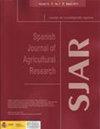Analysis of operating speed and power consumption of a gear-driven rotary planting mechanism for a 12-kw six-row self-propelled onion transplanter
IF 0.8
4区 农林科学
Q3 AGRICULTURE, MULTIDISCIPLINARY
引用次数: 0
Abstract
Aim of study: To determine the optimal working speed of a gear-driven rotary planting mechanism for a self-propelled riding-type onion transplanter in order to choose an adequate forward speed for effective onion (Allium cepa L.) seedling planting. Area of study: Daejeon, Korea. Material and methods: The gear-driven rotary planting mechanism was composed of six planting hoppers that received free-falling onion seedlings through the supply mechanism and deposited them into the soil. To determine the optimal working speed for accurate transplantation of the seedlings, mathematical working trajectory modelling of the planting mechanism, virtual simulations, and validation field experiments were carried out. Main results: According to the model simulation, a forward speed of 0.15 m s-1 of the transplanter and a rotating speed of 60 rpm of the planting mechanism were favourable for seedling uprightness and minimum mulch film damage. For the proposed transplanting mechanism, the free-falling distance was calculated as 0.08 m, and the accuracy for the seedling deposition into the hopper was demonstrated as 97.16% through the validation test. From the field tests, a forward speed of 0.15 m s-1 combined with a transplanting frequency of 60 seedlings min-1 was found to be optimum for obtaining a high seedling uprightness (90o), a low misplant rate (7.66%), a low damage area on mulch film, and low power consumption (36.53 W). Research highlights: The findings of this research might be helpful in improving the design of the onion transplanting mechanism and accelerating the automation process for seedling transplantation.12kw六排自行式洋葱移栽机齿轮传动旋转种植机构运行速度及功耗分析
研究目的:确定自行式坐式洋葱移栽机齿轮驱动旋转栽植机构的最佳工作速度,以选择合适的前进速度进行洋葱(Allium cepa L.)的有效育苗。研究地区:韩国大田。材料与方法:齿轮驱动旋转种植机构由6个种植漏斗组成,通过供给机构接收自由落体洋葱苗,并将其放入土壤中。为了确定秧苗准确移栽的最佳工作速度,进行了栽植机构工作轨迹数学建模、虚拟仿真和田间试验验证。主要结果:根据模型模拟,移栽机的前进速度为0.15 m s-1,栽植机构的转速为60 rpm,有利于秧苗的直立和对地膜的损害最小。对于所提出的移栽机构,计算自由落体距离为0.08 m,通过验证试验,秧苗沉降到料斗中的准确率为97.16%。田间试验结果表明,在前进速度为0.15 m s-1、移栽频率为60苗/ min-1的条件下,可获得较高的苗直度(90°)、较低的错植率(7.66%)、较低的覆膜损伤面积和较低的功耗(36.53 W)。研究重点:本研究结果可为改进洋葱移栽机构设计和加快移栽自动化进程提供参考。
本文章由计算机程序翻译,如有差异,请以英文原文为准。
求助全文
约1分钟内获得全文
求助全文
来源期刊

Spanish Journal of Agricultural Research
农林科学-农业综合
CiteScore
2.00
自引率
0.00%
发文量
60
审稿时长
6 months
期刊介绍:
The Spanish Journal of Agricultural Research (SJAR) is a quarterly international journal that accepts research articles, reviews and short communications of content related to agriculture. Research articles and short communications must report original work not previously published in any language and not under consideration for publication elsewhere.
The main aim of SJAR is to publish papers that report research findings on the following topics: agricultural economics; agricultural engineering; agricultural environment and ecology; animal breeding, genetics and reproduction; animal health and welfare; animal production; plant breeding, genetics and genetic resources; plant physiology; plant production (field and horticultural crops); plant protection; soil science; and water management.
 求助内容:
求助内容: 应助结果提醒方式:
应助结果提醒方式:


